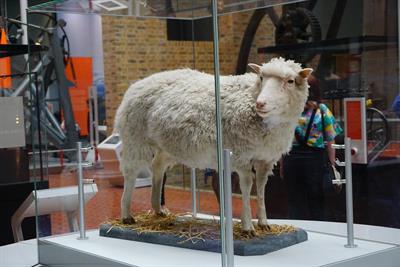PDF chapter test TRY NOW
The cloning of an animal was first successfully demonstrated by Ian Wilmut and his colleagues at the Roslin Institute in Edinburgh, Scotland.

Dolly - The cloned sheep
Dolly was the first cloned mammal, born on 5th July 1996. Dolly was cloned from a cell collected from a Finn Dorsett sheep's mammary gland. Simultaneously an egg was recovered from Scottish blackface ewe. Thus, Finn Dorsett sheep and Scottish blackface ewe were the two sheep used to clone Dolly.
Process of cloning Dolly through Somatic Cell Nuclear Transfer (SCNT):
1. A somatic (body) cell is collected from the mammary gland of the Finn Dorsett sheep.
2. An unfertilised egg cell was collected from the Scottish Blackface ewe, and the nucleus was removed from the egg to form an enucleated egg.
3. The nucleus of the mammary cell of the Finn Dorsett sheep was inserted into the enucleated egg cell of the Scottish Blackface ewe.
4. The new egg cell produced was implanted into the uterus of Scottish Blackface ewe. The development of this egg typically produced the clone Dolly after 148 days.

Process of cloning Dolly through Somatic Cell Nuclear Transfer (SCNT)
Even though Scottish Blackface ewe gave birth to Dolly, it was genetically identical to the Finn Dorsett sheep from which the nucleus was obtained. Dolly lacked the characteristics or features of the Scottish blackface ewe since the nucleus was removed from the egg.
Dolly was a healthy clone of the Finn Dorsett sheep and produced several offspring through normal sexual reproduction. Dolly lived for 6.5 years and died on 14th February 2003 due to lung disease.
Dolly was a healthy clone of the Finn Dorsett sheep and produced several offspring through normal sexual reproduction. Dolly lived for 6.5 years and died on 14th February 2003 due to lung disease.
A video on the process of how Dolly was cloned:
Following Dolly, other attempts to create cloned mammals were made. Many of them, however, die before or shortly after delivery. The cloned animals were frequently discovered to have significant birth defects and severe abnormalities.
Advantages of cloning:
1. Cloning is the production of exactly identical copies of animals.
2. In domesticated animals, superior milk yielding cows are cloned to utilise their benefits.
3. Sheep, which yields high and superior quality wool, is cloned to produce sheep that give a high yield of superior quality.
Reference:
https://upload.wikimedia.org/wikipedia/commons/8/8c/Dolly_clone.svg
https://www.flickr.com/photos/bap824/42266644970
https://www.flickr.com/photos/bap824/42266644970
https://youtu.be/uAOmyOGELAA
